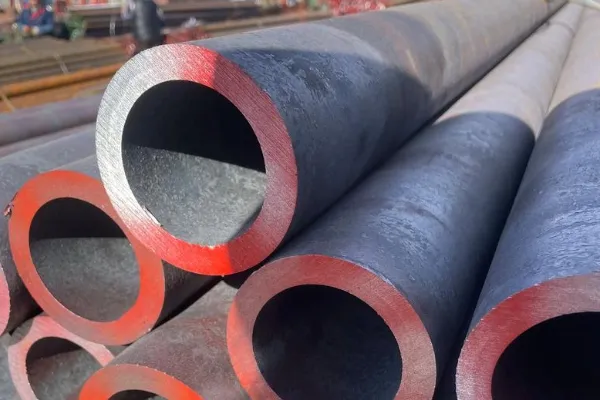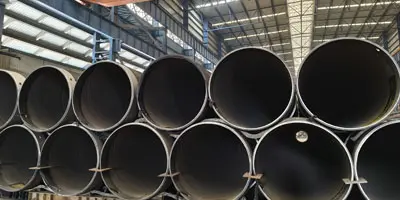ASTM A500 is a steel standard that covers round and shaped cold-formed welded seamless steel structural tubes. Grade B in the ASTM A500 standard is a steel grade used in construction and has a wide range of uses. Grade B is slightly stronger than Grade A, with a yield strength of no less than 315MPa [46,000psi] and a tensile strength of no less than 400MPa [58,000]. It is widely used in various construction and mechanical structure projects due to its excellent structural stability and durability.
ASTM A500 Grade B has a lower yield strength than Grade C, but a higher yield strength than Grade A. The most common application of Grade B steel tubes is construction, used to manufacture a variety of products from tubular steel frames to steel beams.
Specifications: ASTM A500 Grade B
Applications: vehicle frames, roll cages, truck frames, trailers, railings, etc.
Machinability: Easy to weld, cut, form and machine
Properties: Brinell Hardness = 63, Tensile Strength = 58,000 +/-, Yield Strength = 46,000 +/-
OUTSIDE DIMENSIONAL TOLERANCES FOR ASTM A500 SQUARE & RECTANGULAR STEEL TUBING
There are multiple considerations that must be accounted for when determining the outside dimensional tolerances for square and rectangular steel tubing. The chart below and the following attributes describe the exact outside dimensional tolerances for A500 carbon steel.
|
Outside Large Flat Dimension
|
2½ in or under
|
Over 2½ to 3½ in
|
Over 3½ to 5½ in
|
Over 5½ in
|
|
63.5mm or under
|
Over 63.5mm – 88.9mm
|
Over 88.9mm – 139.7mm
|
Over 139.7mm
|
|
Large Flat Dimension Tolerance
|
± 0.020 in
|
± 0.025 in
|
± 0.030 in
|
0.01 times large flat dimension
|
|
± 0.51mm
|
± 0.64mm
|
± 0.76mm
|
ASTM A500 Grade B Square & Rectangle Tubing
For our ASTM A500 Grade B square, rectangular, and special shape tubing, ensuring compliance with the specified ASTM A500 Grade B properties is imperative. It’s noteworthy that a flattening test, although a standard requirement for most, is not mandated for ASTM A500 Grade B non-circular tubes, further distinguishing their unique quality standards within our product range.
|
Grade
|
Yield(min)
|
Tensile (min)
|
Elongation (min)
|
|
Gr. B
|
42,000 psi
|
58,000 psi
|
Determined by wall
|
ASTM A500 Grade B Round Tubing
Below are the physical properties required to meet the three grades that we produce ASTM A500 Grade B round tubing. A flattening test is also a standard requirement for round tubing produced to the ASTM A500 Grade B.
Chemical Requirements of ASTM A500 Grade B Pipes
|
Element
|
Composition, %
|
|
Heat analysis
|
Product analysis
|
|
Carbon
|
0.26
|
0.3
|
|
Manganese
|
1.35
|
1.4
|
|
Phosphorus
|
0.035
|
0.035
|
|
Sulfur
|
0.035
|
0.045
|
|
Copper
|
0.2
|
0.18
|

ASTM A500 Pipe Overview
ASTM A500 is a standard specification for cold-formed welded and seamless carbon steel structural tubing, covering shapes such as round, square, and rectangular tubes. The specification is widely used in the construction and mechanical industries due to its strength, durability, and versatility.
1.Grade B Characteristics
Grade B is one of the designations within the ASTM A500 standard and is known for its balance of strength and workability.
2.Strength:
Yield Strength: ≥ 315 MPa (46,000 psi)
Tensile Strength: ≥ 400 MPa (58,000 psi)
These values make Grade B slightly stronger than Grade A and slightly less strong than Grade C.
3.Hardness:
Brinell Hardness: Approximately 63 (indicative of the material's resistance to deformation).
4.Machinability:
Grade B offers excellent weldability, formability, and machinability, making it easy to work with for various applications.
ASTM A500 Grade B Pipe Application Scenarios
1.Structural Engineering:
Used in bridges, tunnels, flyovers, and pylons, offering high strength and durability in harsh environments.
2.Building Frames and Supports:
Essential for industrial, commercial, and residential framing, providing a reliable foundation for construction safety.
3.Piping and Conveying Systems:
Ideal for transporting liquids and gases due to its excellent workability and corrosion resistance.
4.Superior Mechanical Properties:
High strength and malleability make it suitable for carrying heavy loads in structural and foundation work.
5.Welding Excellence:
Compatible with various methods, including arc, submerged arc, and gas-shielded welding, ensuring strong, high-quality joints.
ASTM A500 square tube standard in the United States
ASTM is the standard of the American Society for Testing and Materials. Specifically, ASTM A500 is: round and special-shaped welded and seamless carbon steel structural square tubes. First of all, it should be explained that this is not a material, but a production standard for square tubes. ASTM A513 resistance-welded carbon steel and alloy steel mechanical square tubes, ASTM A500 structural carbon steel cold-formed round section and special-shaped section welded square tubes and seamless square tubes.
ASTM A335 ferritic alloy steel seamless square tubes for high temperature work
ASTM A500 is divided into grade A and grade B material square tubes
ASTM: American Society for Testing and Materials
ASTM A500 is the standard for welded square tubes.
ASTM A500 B grade, the specific parameters are as follows:
Tensile strength 400Mpa Yield strength 310Mpa Chemical composition: C 0.26 Mn --- P 0.04 S 0.05 You can refer to GB 3094 cold-drawn special-shaped square tube standard.
The
ASTM A500 standard involves many grades of materials, such as Grade A, Grade B, etc. Each grade of material has different performance requirements, and it is not possible to say which standard can be used as a substitute.
Usually, material substitution requires that the substitute material has the same composition and mechanical properties as the replaced material.
The difference between ASTM A500 round tube, ASTM A500 square tube and ASTM A500 rectangular tube
The differences between ASTM A500 round tube, ASTM A500 square, and ASTM A500 rectangular tubes mainly lie in their cross-sectional shapes and applications, not in material or performance.
Square Tubes: Widely used in construction and machinery manufacturing, square tubes offer balanced strength and are ideal for structural frameworks and support columns.
Rectangular Tubes: Known for directional strength, they are used in fluid pipelines, mechanical parts, and engineering structures, including beams and braces. They are also historically utilized in firearms and artillery.
Round Tubes: With uniform strength distribution, round tubes are ideal for resisting external pressure, making them suitable for fluid transport, vehicle frames, and aesthetic applications.
Compared to round tubes, square tubes provide higher compressive strength and lower weight, making them versatile for structural stability and modular designs. Each shape meets specific industrial and structural needs efficiently.






 English
English Español
Español بالعربية
بالعربية











 Phone :
Phone :  Whatsapp :
Whatsapp :  Email :
Email : 


